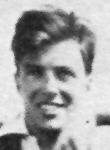
Dahl
 |
Roald Dahl |
| His life - a short description |
Roald Dahl described his life in two books, "Boy" and "Going Solo". The first volume deals with his childhood, the second one with his life after school.
His parents were from Norway, but he was born in Wales, 1916. The family used to spend the summer holidays on a little Norwegian island, swimming, fishing and going by boat. When Roald was four years old, his father died, so his mother had to organise the trip alone for herself and her six children.
At school, he was always homesick. At St. Peter's Prep School, all the letters home were controlled by the headmaster, and afterwards at Repton Public School, he had to wear a horrible school uniform [with braces, waist coat, hat and lots of buttons, all black]. The younger boys were often punished by the headmaster and the older boys called prefects. Roald lays much emphasis on describing the school-beatups in his book. You could get beaten for small mistakes like leaving a football sock on the floor, for burning the prefect's toast at teatime or for forgetting to change into house-shoes at six o'clock. The most terrible beatings, however, were given by the headmaster himself, who was also a clergyman. He was so cruel, that he made a pause after each beat to smoke his pipe and talk about sins and wrongdoing, while the boy had to remain kneeling. After ten beats, the victim was told to wash away the blood first, before putting on the trousers. By the way, this headmaster became later the Archbishop of Canterbury. Roald Dahl kept telling himself, that if this was one of God's chosen men, there was something going very wrong about the whole business.
After school, Roald Dahl didn't go to university, but applied for a job at the Shell company, because he was sure they would send him abroad. He was sent to East Africa, where he got the adventure he wanted: great heat, crocodiles, snakes and safaries. He lived in the jungle, learned to speak Swahili and suffered from malaria. When the second World War broke out, he went to Nairobi to join the Royal Air Force. He was a fighter pilot and shot down German planes and got shot down himself. After 6 months in hospital he flew again.
In 1942, he went to Washington as Assistant Air Attaché. There, he started writing short stories. In 1943, he published his first children's book "The Gremlins" with Walt Disney and in 1945 his first book of short stories appeared in the US. His marriage with the actress Patricia Neal was unhappy. None of their kids survived, his wife suffered a stroke. When she regained consciousness, she could hardly read, count and talk. But Roald managed to nurse her back to health, so that she could act again. Nevertheless, he got divorced in 1983 and married Felicity Crosland. He recieved several awards, such as the Edgar Allan Poe Award.
His collections of short stories have been translated into many languages and have been best-sellers all over the world. Among them are "Someone Like You", "Sweet Mystery Of Life", "Kiss Kiss" and "Roald Dahl's Book of Ghost Stories". He wrote TV series like "Tales of the Unexpected" and the novel "My Uncle Oswald".
His books are mostly fantasy, and full of imagination. They are always a little cruel, but never without humour - a thrilling mixture of the grotesque and comic. A frequent motif is, that people are not, what they appear to be. Mary Maloney in "Lamb to the Slaughter", for example, is not a friendly widow, but a clever murderess. In his stories, the background is perfectly worked out: details are very close to reality.
Roald Dahl didn't only write books for grown-ups, but also for children, such as "James and the Giant Peach", "Fantastic Mr. Fox" and "The Gremlins". About his children's stories he said once: "I make my points by exaggerating wildly. That's the only way to get through to children." Roald Dahl is perhaps the most popular and best-selling children's book author. However, these stories are so sarcastic and humorous, that also adults appreciate reading them.
Roald Dahl died in November 1990. The Times called him "one of the most widely read and influential writers of our generation"
| Some summarys of his short stories |
| last update: April 7, 1997 |
| © Copyright by Johannes Schmid |